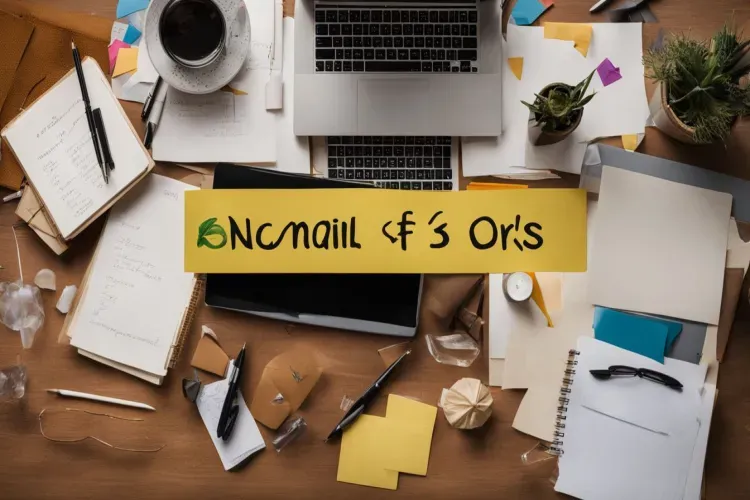Having trouble getting meetings on your calendar? You’re not alone. A solid meeting request email can be the key to unlocking those appointments. Our article will walk you through creating no-fuss, effective email templates that open doors.
Let’s get started—your next successful meeting is just an email away.
The Importance of Meeting Request Emails

Meeting request emails are key. They make talking smooth and work fast.
Enhancing Communication
Good emails make talking easier. In real estate, when you send a professional email to request a meeting, it opens doors. I found that using clear email subject lines grabbed attention fast.
This trick helped me schedule more meetings than ever before! It’s like having the right key for every door.
Self introductions in emails are gold. They tell people who you are and why you’re reaching out. This makes your message stand out in a crowded inbox. I always personalize my greeting too—it shows respect and builds a connection right away, which is crucial in our line of work.
Increasing Efficiency
Using email templates to ask for meetings saves you time. You do not have to start from scratch every time you need to talk business with someone new or schedule a one-on-one. This way, real estate agents can focus more on selling homes and less on typing emails.
A good subject line makes your email stand out in a busy inbox. This is key because it helps ensure your message gets read quickly.
By setting up meetings through email, you also keep track of all the details in one place. It’s easy to go back and see what was agreed upon without needing to remember every phone call or text message.
Plus, automated reminders can help both you and the person you’re meeting stay on top of things without extra work. So, writing effective meeting request emails not only clears up confusion but also lets everyone know exactly when and where the meeting will happen, leading to better-prepared discussions and more successful outcomes.
Key Elements of a Successful Meeting Request Email

To get a “yes” to your meeting request, every email must have key parts. Think of it as making the perfect sandwich—the right ingredients make all the difference. Your subject line is like the bread; it has to be just right or no one will want it.
A personal touch in your greeting is like adding the best sauce, making everything more appealing. Explain who you are and why you’re reaching out—this is your filling, giving substance to the message.
Then, suggest when you could meet as if setting down plates and utensils—without this step, how can anyone join you? End with asking them directly if they’ll come to your table and let them know you’ll check back soon—like offering dessert before clearing dishes away.
This way, every part of your email works hard to turn that meeting into reality.
Clear Subject Line
A clear subject line grabs attention. It tells the person what your email is about in just a few words. For real estate agents and realtors, this means using words that show you want to schedule a meeting or discuss something important.
I once sent an email with the subject “Quick Chat About Your Property Listing?” This got a fast reply because it was direct and specific.
Use action words like “schedule,” “discuss,” or “update” in your subject lines. This helps the receiver know exactly what you expect from them after opening the email. Avoid vague phrases that might make your message get lost among dozens of others.
Always aim for simple yet strong language that conveys your purpose without needing them to read more than necessary.
Personalized Greeting
Starting your meeting request email with a personalized greeting sets the tone for the rest of your message. Use the recipient’s name to make it feel like you’re talking directly to them.
This small step can make a big difference in how they view your email. I learned this early in my career as a real estate agent when trying different ways to secure meetings via email.
Emails that began with “Dear [Name]” got more responses than those that started with generic greetings.
A tailored hello shows respect and grabs attention, two things every real estate professional values. It’s not just about being polite; it’s about making an immediate connection with someone you might be doing business with.
Think of it as laying down a welcome mat at their digital doorstep—a simple, effective way to invite them into a conversation about scheduling that important meeting or property showing.
Self Introduction
Introduce yourself right off the bat in your meeting request email. Say who you are and what you do. If you’re a real estate agent, mention that. This makes it clear why you’re reaching out.
Also, drop in how you know them or found their contact. This could be from a mutual connection or an event related to houses and properties.
Next, talk briefly about your work history but keep it relevant to the meeting’s purpose. For example, if the goal is to discuss selling a house, share how many homes you’ve helped sell this year.
This shows you’re skilled and sets the stage for what’s next – discussing how you can help them specifically with their property needs.
Purpose of the Meeting
The goal of the meeting is key for a real estate agent. You need to share why this sit-down matters. Maybe you want to talk about selling a house or finding the perfect office space.
Be clear in your email. Say, “I’d like to meet and discuss listing your property,” or “Let’s chat about what you’re looking for in a new home.” This way, the person knows what the talk is about before it starts.
In my work, I always include when and where I think we should meet in my emails. It makes planning easier for both sides. I suggest two or three times and ask what works best for them.
This approach shows respect for their schedule while still moving forward with our plans to connect on buying or selling property.
Proposed Times and Dates
Choosing good times and dates for a meeting can make a big difference. It’s smart to offer options. This means giving a few different days and times you’re free. I found this works well in my job as a real estate agent.
People are busy, so they appreciate choices.
In your meeting request email, say something like “I’m available Tuesday at 10 AM or Thursday at 3 PM – let me know what fits best for you.” This way, you show respect for the other person’s schedule.
Plus, it speeds up setting the date since they can just pick an option that works for them too. This simple step really helps get meetings onto calendars faster!
Call to Action
End your meeting request email with a strong call to action. Ask them directly to reply with their availability or confirm the meeting time you proposed. Make it easy for them by suggesting a quick reply like, “Can you meet on Tuesday at 10 AM?” This approach worked well for me in my real estate dealings.
It cuts through delays and gets straight to scheduling that important discussion.
Include options too. Say something like, “If Tuesday doesn’t work, please suggest two times that do.” This shows respect for their schedule while keeping the focus on locking in a time.
You’re guiding them towards the next step without leaving room for uncertainty. Keep it clear and straightforward – this nudges people to respond faster because they know exactly what’s being asked of them.
Follow Up
After you send a meeting request email, waiting for a reply can feel like forever. That’s why following up is key. It keeps the conversation going and shows your interest. In my work as a real estate agent, I’ve found that sending a polite reminder helps.
I usually wait about two days before reaching out again. This gives them enough time to check their schedule without feeling rushed.
In this follow-up message, make sure to mention the initial email gently. You can say something like “Just checking in on my previous message…” Also, offer more times for the meeting if needed.
This flexibility often makes it easier for them to say yes. And always end with a friendly note that invites them to get back to you when they can.
Efficient Meeting Request Email Templates
Check out these smart email setups for asking to meet. They make talking easy, whether you’re catching up with someone you know or reaching out to a brand-new contact. These templates are like a quick guide—pick one, fill in your details, and you’re ready to go.
Get ready to boost how you talk with others through emails today!
Template for Scheduling a Meeting with a Known Colleague
Scheduling a meeting with a colleague you already know can be straightforward. You can make it even easier by following these simple steps.
- Use a clear subject line. Start with “Meeting Request – [Your Name].” This helps your email stand out in their inbox.
- Begin with a personalized greeting. Say “Hi [Colleague’s Name],” to make the email feel more personal.
- Introduce yourself briefly, even if you know them well. A simple “It’s [Your Name] from the [Department/Team Name]” will do.
- Explain why you want to meet. Be concise – something like, “I’d like to discuss [meeting purpose] to better assist our clients.”
- Suggest times and dates for the meeting. Offer at least two options like “Are you free this Thursday afternoon or Friday morning?”
- Include a call to action asking for their availability, such as, “Please let me know your availability,” or “Can we schedule this meeting on one of those days?”
- Plan a follow – up by saying, “If I don’t hear back, I’ll touch base early next week.” This keeps things moving forward.
Keep these steps in mind when writing your email, and use simple tools like calendar invitations and reminders to stay organized and ensure the meeting happens as planned.
Template for Requesting a Meeting with a New Contact
Meeting new people is key in real estate. A perfect email can make this easier. Here’s how you write that email to ask for a meeting:
- Start with a strong subject line. This grabs their attention. Think, “Quick chat about [Area/House] opportunities?”
- Say hello in a warm way. Use their name to make it personal, like “Hi Alex,”
- Introduce yourself clearly. Mention your job and how you found them, maybe through a mutual friend or online research.
- Talk about why you’re reaching out. Explain briefly what makes you want to meet them. Maybe it’s their work in the community or a shared interest.
- Suggest times and places to meet. Offer options but be flexible, like “Are you free next week for coffee at Café Central?”
- End with a call to action that’s easy to follow. Ask them to reply with their preferred time or if they’d like a call instead.
- Include a polite sign – off and your contact info.
Using these steps helped me when I was newer in real estate and trying to grow my network quickly and efficiently—especially the part about giving clear times for potential meetings made planning so much smoother for both parties!
Template for a Cold Meeting Request
Crafting a cold meeting request email might seem tough, especially if you’re reaching out to someone you haven’t met before. Real estate agents and realtors need effective ways to catch attention without seeming pushy.
Here’s how to do it:
- Start with a powerful subject line: Your subject should grab the reader’s interest right away. Use their name and mention something specific that shows you’ve done your homework. For example, “John, your insights on downtown properties could shape our strategy.”
- Personalize your greeting: Instead of a simple “Hello,” use the person’s name. It shows respect and starts building a connection.
- Introduce yourself briefly: In one or two sentences, say who you are and what you do. Make sure it’s clear why you’re reaching out to them specifically.
- State why you’re emailing: Get to the point fast. Mention something they did that impressed you or caught your eye. This flatters them but also sets the stage for why you’re reaching out.
- Explain the purpose of the meeting clearly: Be direct about what you hope to discuss or achieve during the meeting. If it’s advice you want, say so.
- Propose specific times and dates: Offer two or three options for when you could meet. Be flexible and considerate of their schedule.
- Include an easy way for them to respond: A straightforward question like “Do any of these times work for you?” invites a quick reply.
- Sign off politely but confidently: End with a thank-you note for considering your request and add a positive note looking forward to their reply.
I remember sending my first cold meeting request; I was nervous but stuck to these steps, especially focusing on personalization and demonstrating genuine interest in their work—not just what I hoped to gain from our conversation. The response was more favorable than I had anticipated; they appreciated my approach and were open to discussing further over coffee!
This template is built on proven practices: keep it short, focus on building rapport, show value, be respectful of time, and most importantly—make replying as easy as possible for them.
Template for Product Demo Request
Good emails make things happen. A well-crafted email can set up a product demo smoothly. Here’s how you can write one for effective communication.
- Start with a strong subject line – This tells the receiver exactly what to expect. Use phrases like “Request for Product Demo: [Product Name]” to grab attention quickly.
- Include a personal greeting – Use the person’s name. It shows respect and grabs their interest.
- Briefly introduce yourself – Mention your job title and how you found out about their product. It builds context.
- Clearly state the purpose of your email – Explain why you are interested in their product and how it could benefit your real estate business.
- Suggest possible times and dates for the demo – Offer options that work for you, but be ready to adjust based on their availability.
- End with a call to action – Ask them to confirm a time or suggest another if none of yours work.
- Follow up if needed – If you haven’t heard back in a week, send a polite reminder.
I once sent an email using this format to ask for a software demo that could help manage my property listings more effectively. The clear subject line made my intent obvious, so the recipient knew right away what I needed from them. By suggesting several dates and times, we were able to schedule something without too many back-and-forth messages, saving time on both ends.
This approach supports consistency in communication and enhances efficiency by making sure everyone knows the meeting’s purpose from the start while also respecting each other’s schedules through proposed timings. Plus, incorporating automation tools can streamline this process even more, keeping track of responses and reminders efficiently.
Benefits of Automated Meeting Request Emails
Automated meeting request emails make life easier for real estate agents and realtors. They save time by sending out invitations to connect without having to do it manually every time.
This means more time focusing on clients and less on admin work. These emails can also track who has opened the invite and who hasn’t yet responded, making follow-ups simpler.
Using these smart tools ensures that your messages are clear, professional, and get straight to the point. They help in setting up meetings faster with potential home buyers or sellers because they include all necessary details like suggested dates, times, and the purpose of the meeting.
Clients appreciate this efficiency, leading to better communication and more successful appointments booked through email requests.
Conclusion
Efficient email blueprints for setting up meetings are key. They make sure we talk well and set up appointments without trouble. Using the right words, being clear, and following a structure can work wonders.
With these templates, real estate agents find it easier to plan talks and showings. So, diving into these examples helps in getting the meeting you want fast and smoothly. This guide aims to make your email tasks simpler and more successful.
For more insights on enhancing your business strategies, check out our article on leveraging big data in real estate.





Leave a Reply